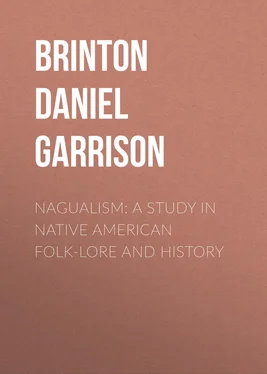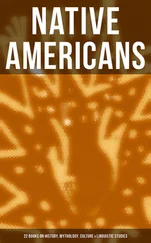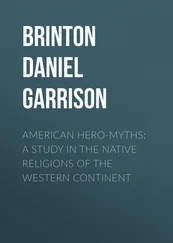Daniel Brinton - Nagualism - A Study in Native American Folk-lore and History
Здесь есть возможность читать онлайн «Daniel Brinton - Nagualism - A Study in Native American Folk-lore and History» — ознакомительный отрывок электронной книги совершенно бесплатно, а после прочтения отрывка купить полную версию. В некоторых случаях можно слушать аудио, скачать через торрент в формате fb2 и присутствует краткое содержание. ISBN: , Жанр: foreign_antique, foreign_prose, на английском языке. Описание произведения, (предисловие) а так же отзывы посетителей доступны на портале библиотеки ЛибКат.
- Название:Nagualism: A Study in Native American Folk-lore and History
- Автор:
- Жанр:
- Год:неизвестен
- ISBN:http://www.gutenberg.org/ebooks/26426
- Рейтинг книги:4 / 5. Голосов: 1
-
Избранное:Добавить в избранное
- Отзывы:
-
Ваша оценка:
- 80
- 1
- 2
- 3
- 4
- 5
Nagualism: A Study in Native American Folk-lore and History: краткое содержание, описание и аннотация
Предлагаем к чтению аннотацию, описание, краткое содержание или предисловие (зависит от того, что написал сам автор книги «Nagualism: A Study in Native American Folk-lore and History»). Если вы не нашли необходимую информацию о книге — напишите в комментариях, мы постараемся отыскать её.
Nagualism: A Study in Native American Folk-lore and History — читать онлайн ознакомительный отрывок
Ниже представлен текст книги, разбитый по страницам. Система сохранения места последней прочитанной страницы, позволяет с удобством читать онлайн бесплатно книгу «Nagualism: A Study in Native American Folk-lore and History», без необходимости каждый раз заново искать на чём Вы остановились. Поставьте закладку, и сможете в любой момент перейти на страницу, на которой закончили чтение.
Интервал:
Закладка:
“Dost thou suck the blood of others, or dost thou wander about at night, calling upon the Demon to help thee? Hast thou drunk peyotl , or hast thou given it to others to drink, in order to find out secrets, or to discover where stolen or lost articles were? Dost thou know how to speak to vipers in such words that they obey thee?” 8 8 Nicolas de Leon, Camino del Cielo , fol. 111 (Mexico, 1611).
4.This interesting passage lets in considerable light on the claims and practices of the nagualists. Not the least important item is that of their use of the intoxicant, peyotl , a decoction of which it appears played a prominent part in their ceremonies. This is the native Nahuatl name of a certain plant, having a white, tuberous root, which is the part employed. It is mentioned as “pellote” or “peyote” in the Farmacopea Mexicana as a popular remedy, but its botanical name is not added. According to Paso y Troncoso, it is one of the Compositæ, a species of the genus Cacalia . 9 9 Paso y Troncoso, in Anales del Museo Nacionàl de Mexico , Tom. iii, p. 180.
It is referred to in several passages by Father Sahagun, who says that it grows in southern Mexico, and that the Aztecs derived their knowledge of it from the older “Chichimecs.” It was used as an intoxicant.
“Those who eat or drink of this peyotl see visions, which are sometimes frightful and sometimes ludicrous. The intoxication it causes lasts several days. The Chichimecs believed that it gave them courage in time of danger and diminished the pangs of hunger and thirst.” 10 10 Sahagun, Historia de Nueva España , Lib. x, cap. 29, and Lib. xi, cap. 7. Hernandez has the following on the mysterious properties of this plant: “Illud ferunt de hac radice mirabile (si modo fides sit vulgatissimæ inter eos rei habendæ), devorantes illam quodlibet prsæsagire prædicereque; velut an sequenti die hostes sint impetum in eos facturi? Anne illos felicia maneant tempora? Quis supellectilem, aut aliud quidpiam furto subripruerit? Et ad hunc modum alia, quibus Chichimecæ hujusmodi medicamine cognoscendis.” Franciscus Hernandus, Historia Plantarum Novæ Hispaniæ , Tom. iii, p. 71 (Ed., Madrid, 1790).
Its use was continued until a late date, and very probably has not yet died out. Its composition and method of preparation are given in a list of beverages prohibited by the Spanish authorities in the year 1784, as follows:
“ Peyote : Made from a species of vinagrilla, about the size of a billiard ball, which grows in dry and sterile soil. The natives chew it, and throw it into a wooden mortar, where it is left to ferment, some leaves of tobacco being added to give it pungency. They consume it in this form, sometimes with slices of peyote itself, in their most solemn festivities, although it dulls the intellect and induces gloomy and hurtful visions (sombras muy funestas).” 11 11 Diccionario Universal , Appendice, Tom. i, p. 360 (Mexico, 1856).
The peyotl was not the only herb prized as a means of casting the soul into the condition of hypostatic union with divinity. We have abundant evidence that long after the conquest the seeds of the plant called in Nahuatl the ololiuhqui were in high esteem for this purpose. In the Confessionary of Father Bartholomé de Alva the priest is supposed to inquire and learn as follows:
“ Question. Hast thou loved God above all things? Hast thou loved any created thing, adoring it, looking upon it as God, and worshiping it?
“ Answer. I have loved God with all my heart; but sometimes I have believed in dreams, and also I have believed in the sacred herbs, the peyotl , and the ololiuhqui ; and in other such things ( onicneltocac in temictli, in xiuhtzintli, in peyotl, in ololiuhqui, yhuan in occequitlamantli ).” 12 12 Confessionario Mayor y Menor en lengua Mexicana , fol. 8, verso (Mexico, 1634).
The seeds of the ololiuhqui appear to have been employed externally. They were the efficient element in the mysterious unguent known as “the divine remedy” ( teopatli ), about which we find some information in the works of Father Augustin de Vetancurt, who lived in Mexico in the middle of the seventeenth century. He writes:
“The pagan priests made use of an ointment composed of insects, such as spiders, scorpions, centipedes and the like, which the neophytes in the temples prepared. They burned these insects in a basin, collected the ashes, and rubbed it up with green tobacco leaves, living worms and insects, and the powdered seeds of a plant called ololiuhqui , which has the power of inducing visions, and the effect of which is to destroy the reasoning powers. Under the influence of this ointment, they conversed with the Devil, and he with them, practicing his deceptions upon them. They also believed that it protected them, so they had no fear of going into the woods at night.
“This was also employed by them as a remedy in various diseases, and the soothing influence of the tobacco and the ololiuhqui was attributed by them to divine agency. There are some in our own day who make use of this ointment for sorcery, shutting themselves up, and losing their reason under its influence; especially some old men and old women, who are prepared to fall an easy prey to the Devil.” 13 13 Vetancurt, Teatro Mexicano , Trat. iii, cap. 9.
The botanist Hernandez observes that another name for this plant was coaxihuitl , “serpent plant,” and adds that its seeds contain a narcotic poison, and that it is allied to the genus Solanum , of which the deadly night-shade is a familiar species. He speaks of its use in the sacred rites in these words:
“Indorum sacrifici, cum videri volebant versari cum superis, ac responsa accipere ab eis, ea vescebantur planta, ut desiperent, milleque phantasmata et demonum observatium effigies circumspectarent.” 14 14 Hernandez, Historia Plantarum Novæ Hispaniæ , Tom. iii, p. 32.
Of the two plants mentioned, the ololiuhqui and the peyotl , the former was considered the more potent in spiritual virtues. “They hold it in as much veneration as if it were God,” says a theologian of the seventeenth century. 15 15 Dr. Jacinto de la Serna, Manual de Min stros de Indios para el Conocimiento de sus Idolatrias y Extirpacion de Ellas , p. 163. This interesting work was composed about the middle of the seventeenth century by a Rector of the University of Mexico, but was first printed at Madrid, in 1892, from the MS. furnished by Dr. N. Leon, under the editorship of the Marquis de la Fuensanta del Valle.
One who partook of these herbs was called payni (from the verb pay , to take medicine); and more especially tlachixqui , a Seer, referring to the mystic “second sight,” hence a diviner or prophet (from the verb tlachia , to see).
Tobacco also held a prominent, though less important, place in these rites. It was employed in two forms, the one the dried leaf, picietl , which for sacred uses must be broken and rubbed up either seven or nine times; and the green leaf mixed with lime, hence called tenextlecietl (from tenextli , lime).
Allied in effect to these is an intoxicant in use in southern Mexico and Yucatan, prepared from the bark of a tree called by the Mayas baal-che . The whites speak of the drink as pitarilla . It is quite popular among the natives, and they still attribute to it a sacred character, calling it yax ha , the first water, the primal fluid. They say that it was the first liquid created by God, and when He returned to His heavenly home He left this beverage and its production in charge of the gods of the rains, the four Pah-Ahtuns. 16 16 MSS. of the Licentiate Zetina, and Informe of Father Baeza in Registro Yucateco , Tom. i.
Интервал:
Закладка:
Похожие книги на «Nagualism: A Study in Native American Folk-lore and History»
Представляем Вашему вниманию похожие книги на «Nagualism: A Study in Native American Folk-lore and History» списком для выбора. Мы отобрали схожую по названию и смыслу литературу в надежде предоставить читателям больше вариантов отыскать новые, интересные, ещё непрочитанные произведения.
Обсуждение, отзывы о книге «Nagualism: A Study in Native American Folk-lore and History» и просто собственные мнения читателей. Оставьте ваши комментарии, напишите, что Вы думаете о произведении, его смысле или главных героях. Укажите что конкретно понравилось, а что нет, и почему Вы так считаете.












